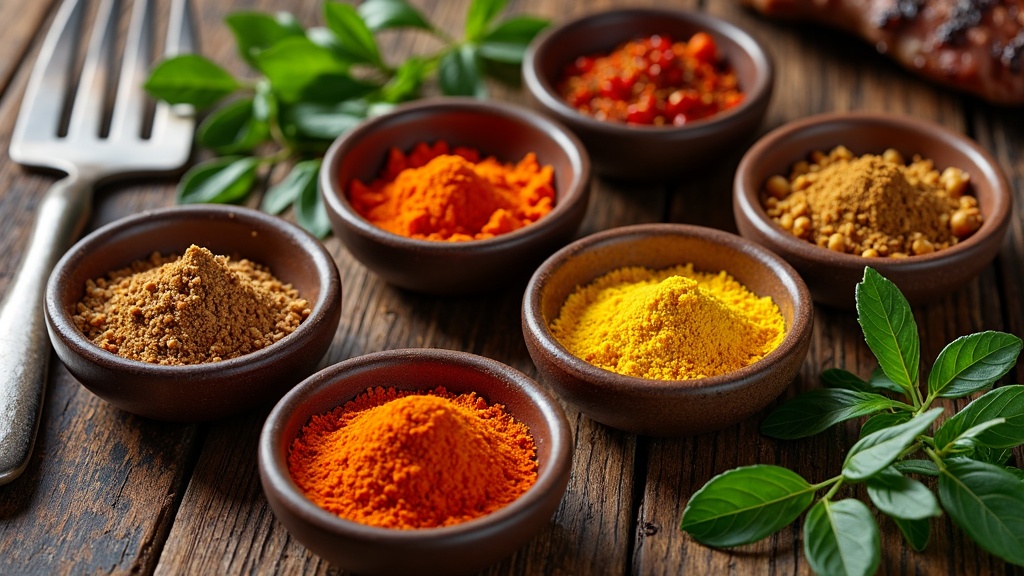Knowing the difference between a rub and a seasoning for grilling or smoking can really impact how your food turns out. If you’ve ever stood in the spice aisle, trying to pick which jar goes best with ribs—and which works better on steak or vegetables—you’re definitely not alone. Here’s my detailed take on how rubs and seasonings are used, what makes each one special, and why choosing the right one can take your next barbecue up a notch.

Rubs and Seasonings: What’s the Difference?
If grilling or smoking is something you love (or want to get into), you’ll hear both “rubs” and “seasonings” being talked about a lot. They each add flavor to meat, fish, or vegetables, but do their jobs in slightly different ways. Let’s break down what makes each unique and how they show up in backyard cooking.
A rub is usually a blend of dried herbs, spices, and sometimes sugar or salt. You rub it right onto the surface of meat—think brisket, ribs, or chicken—before you cook. Rubs matter a lot in barbecue because they help form a tasty, crispy bark on smoked meats.
A seasoning generally refers to any mix of salt, spices, herbs, or flavorings meant to give a boost to taste. Seasoning blends can be sprinkled on before, during, or after cooking—not necessarily rubbed in. They’re super flexible. Seasonings might be simple, like salt and pepper, or complex, like an Italian herb blend for veggies or a steakhouse-style mix for beef.
How Rubs Work in Grilling and Smoking
Rubs are about building flavor right on the surface of your food. When you put a rub on meat before grilling or smoking, the mix of spices and sugar interacts with heat to create what’s called “bark.” That’s the caramelized, textured crust you see on smoked brisket or ribs, and it adds plenty of flavor and crunch with every bite.
Here are the main things rubs do:
- Add Bold Flavor: Rubs use strong flavors, like smoky paprika, brown sugar, garlic, black pepper, and chili powder, which hold up to long cook times.
- Create Bark: Sugar and spices caramelize in the heat, forming a crust. This is part of why barbecue fans get so excited about the perfect rub.
- Help With Texture: Rubs draw out some moisture, allowing a meat’s outer layer to get crusty and super tasty.
- Sometimes Tenderize: Some rubs have salt or certain spices (like mustard powder or acidic elements) that can gently tenderize the meat as they sit.
How Seasonings Fit Into the Grilling Game
Seasonings have more to do with rounding out and boosting the natural flavors of your meat or vegetables. You can add seasonings right before, during, or even after cooking. They typically focus less on forming a crust and more on making overall taste pop.
Seasonings are used to:
- Add Subtle Flavor: Seasonings are often milder—sometimes just salt and pepper, or a touch of garlic or herbs—making them super adaptable. You can use them on steak, chicken, seafood, or even vegetables like corn and peppers.
- Finish a Dish: Many cooks sprinkle finishing salt or a bit of steak seasoning right at the end, not just before you put food on the grill.
- Layer Flavors: You can add a base seasoning, then finish with extra touches like lemon juice, crisp herbs, or sauces, so the natural taste isn’t lost.
Key Differences in Ingredients and Where They Shine
You’ll see some overlap in spices, but rubs and seasonings each bring their own thing to the table, especially in how they taste and work during grilling.
- Rubs: Bold spices, coarser salt, more sugar, plus possible extras like mustard, cumin, or chili powders. Rubs are best for slow-cooking and bigger, heartier cuts of meat.
- Seasonings: Usually finer ground, with less sugar, and designed to highlight the food’s original flavor. Seasonings shine on quick-cooked dishes and make for a great final touch at the table.
My Best Rub and Seasoning Tips for Home Cooks
Cooking at home gets even more enjoyable when you start to use different spice blends. These are a few things I’ve tracked down through my own grilling experiments:
- Go big on rubs for large cuts. For smoking brisket or ribs, use a thick layer of rub. Let it rest so flavors soak in before cooking.
- Seasoning blends fit everyday grilling. For chicken, steaks, burgers, or vegetables, I reach for a pre-mixed seasoning and sprinkle it just before grilling. It gives a perfect bump in taste without overwhelming the dish.
- Try layering. Use a rub before grilling and finish with a fresh sprinkle of herbs or a lighter seasoning when serving.
- Homemade is fantastic. You control salt, heat, and sweetness, and adjust flavors how you want—plus, it’s fun to experiment.
Common Ingredients in Rubs vs. Seasonings
These are some of the usual ingredients to keep an eye out for:
- In Rubs: Paprika, chili powder, black pepper, brown sugar, cumin, garlic powder, onion powder, coarse salt, cayenne.
- In Seasonings: Salt, pepper, dried herbs (like oregano, thyme, basil), garlic powder, onion powder, citrus zest, and sometimes a hint of smoked paprika or chili.
When to Use a Rub and When a Seasoning is Better
What you decide to use depends on your dish and what kind of flavor impact you’re looking for.
- Use a rub for: Barbecue, smoked meats, pulled pork, brisket, ribs, pork chops, or grilled chicken thighs, where you want that textured and flavorful crust.
- Use seasoning for: Fast-cooked meats, chicken breast, steaks, vegetables, or even as a finishing touch after food leaves the grill.
Popular Rub and Seasoning Styles from Across the Globe
Grilling styles are as varied as the regions they come from, and you’ll stumble upon all kinds of unique rubs and seasonings as you explore different cuisines. Here are a few to try or look up for next-level cool inspiration:
- American BBQ (Southern styles): Famous for their sweet, smoky rubs loaded with brown sugar and paprika, ideal for slow smoking and developing bark.
- Mexican: Blends rich with chiles, cumin, and lime; amazing on grilled chicken, fish, or even corn.
- Mediterranean: Herb-packed seasoning mixtures using oregano, lemon zest, thyme, and olive oil; these are perfect for lamb or grilled vegetables.
- Indian: Spice mixtures—masalas—that are used as rubs or seasonings for grilled meats, paneer, and vegetables.
- Asian: Dry or wet rubs with flavors like ginger, garlic, and five spice, often finished with sesame or soy sauce for added zing.
Common Mistakes: Mixing Up Rubs and Seasonings
There are a few errors I’ve made (and seen plenty of friends make) when stepping into the rubs vs. seasonings debate by the grill.
- Overdoing salt with rubs. Rubs often contain salt. Watch out adding even more salty seasoning or you’ll end up with an overpowering taste, especially if you’re doing a long smoke.
- Picking the wrong blend for the job. Fine, powdery blends just won’t give you that bark on barbecue. Stick with coarser rubs to make your bark pop.
- Skipping rest time. Good rubs need a little time to soak into the meat before cooking, so don’t rush that step.
- Using bold rubs on delicate foods. Strong flavors can bury seafood or light vegetables. Use gentler seasonings on these to keep their original taste shining through.
Advanced Flavor Tricks With Rubs and Seasonings
Once you’re comfortable with the basics, you can start mixing and playing with techniques that really let your flavors pop. Here are some pro moves to check out:
- Double Layering: Apply a dry rub before cooking, then finish the dish with a light coat of seasoning after grilling. You end up with layers of flavor.
- Oil or Acid Pastes: Mix your rub with olive oil, citrus juice, or vinegar for a wet paste. This works for marinating and adds extra tenderness to meat.
- Toasting Spices: Toast whole or ground spices briefly in a dry skillet before using. This trick makes their flavor much stronger.
- Sweet and Spicy Balancing: A pinch of honey or a sprinkle of sugar can mellow out spicy rubs, making your bark more nuanced and tasty.
- Try Herb Finishes: Sprinkling chopped fresh herbs on after grilling can make both rubs and seasonings feel fresher. This is especially good with lighter meats or vegetables.
What Should You Keep Stocked?
Setting up your spice rack for grilling means keeping the basics on hand so you’re ready for any meat or veggie. These are my essentials:
- For Rubs: Paprika (smoked and regular), coarse kosher salt, brown sugar, black pepper, cumin, chili powder, garlic powder, onion powder, cayenne pepper.
- For Seasonings: Sea salt, cracked black pepper, garlic powder, Italian herbs, citrus zest, dried parsley, and at least one smoky or spicy blend for chicken or veggies.
Frequently Asked Questions
Here are some of the questions that keep coming up about rubs and seasonings for the grill:
Question: Can I use a rub and a seasoning together?
Answer: Absolutely! Some folks put on a bold rub to start, then finish with a dash of seasoning right before serving. Just keep the salt in mind to avoid overdoing it.
Question: Can I swap in one for the other?
Answer: Sometimes you can, but the results will be a little different. Using a coarse rub as a seasoning might feel a bit much, and using a fine-grain seasoning as a rub won’t give you that signature bark on smoked meats.
Question: How long should I let a rub sit?
Answer: Let your rub sit for at least 30 minutes—longer for big meats, even overnight if possible, as long as there isn’t too much salt. This gives flavors time to sink in.
Question: Are homemade blends better?
Answer: Making your own blends means you can adjust salt, heat, and sugar however you like. Store-bought mixes are convenient and steady, so it’s about what matters most—ease or control.
Wrapping Up
Getting a feel for the difference between a rub and a seasoning opens up all sorts of possibilities for grilling and home smoking. The right pick levels up flavor and matches your cooking style or your guests’ cravings. From rich barbecue with a firm bark to quick grilled veggies, having a good selection of rubs and seasonings on hand means you can roll with whatever your summer barbecue has in store.
Keep experimenting, tweak things to your taste, and taste everything along the way—half the fun is tracking down your favorites and mixing up new blends. Happy grilling!
